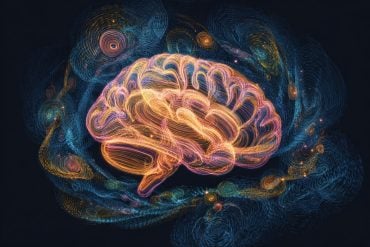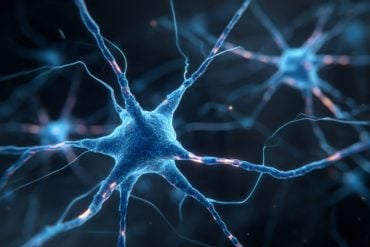Summary: Amidst noise and chaos, cortical neurons work in a team to communicate and allow the brain to find order.
Source: EPFL
Neurons communicate with each other by sending out rapid pulses of electrical signals called spikes. At first glance, the generation of these spikes can be very reliable: when an isolated neuron is repeatedly given exactly the same electrical input, we find the same pattern of spikes. Why, then, does the activity of cortical neurons in a live animal fluctuate and actually seem so variable?
There are two reasons for this. Firstly, when transmitting a signal to another neuron, the process can sometimes fail and these failures are unpredictable – like rolling a die to decide on an outcome. “We estimate the chance of a synapse between two cortical pyramidal neurons passing a chemical neurotransmitter signal can be as low as 10%,” explains lead researcher Max Nolte. This uncertainty means that a neuron will hear the same message sent by connected neurons differently every time.
Secondly, when the two fundamental types of cortical neurons (excitatory and inhibitory) are interconnected in a network, small uncertainties in activity patterns become amplified. This leads to unpredictable patterns, a behavior that is called chaos.
This backdrop of noise and chaos suggests that individual cortical neurons cannot find order and fire reliable spikes, and so the brain has to ‘average’ the activity of many neurons for certainty – listen to the whole choir instead of individual singers.
Simulation neuroscience finds the answer
The experimental manipulations required to untangle the noise sources in the brain and evaluate their impact on neuronal activity are currently impossible to perform in a live animal in vivo, or even in separated brain tissue in vitro. “For the moment, it is simply not possible to monitor all of the thousands of brain-wide inputs to a neuron in vivo, nor to turn on and off different noise sources,” says Nolte. The closest approximation of cortical tissue to date in a model is the Blue Brain Project’s biologically detailed digital reconstruction of rat neocortical microcircuitry (Cell 2015). This computer model provided the ideal platform for the researchers to study to what degree the voices of individual neurons can be understood, as it contains data-constrained models of the unreliable signal transmission between neurons.

Using this model, they found that activity that is spontaneously generated from the interconnected neurons is highly noisy and chaotic, depicting very different spike times in each repetition. “We studied the origin and nature of cortical internal variability with a biophysical neocortical microcircuit model with biologically realistic noise sources,” reveals Nolte. “We observed that the unreliable neurotransmitter signals are amplified by recurrent network dynamics, causing a rapidly decaying memory of the past – a sea of noise and chaos.”
Reliable responses amidst noise and chaos
But, of course, the mammalian brain does not have a rapidly decaying memory. In fact, perhaps the most fascinating insight from the findings is that spike times that were highly unreliable during spontaneous activity became highly reliable when the circuit received external inputs. This phenomenon was not simply a result of strong external input directly driving the neurons to reliable responses. Even weak thalamocortical input could switch the network briefly to a regime of highly reliable spiking. At that point, the interactions between the neurons that otherwise amplify uncertainty and chaos conversely amplify reliability and allow the brain to find order.
“Thalamocortical stimuli can prompt reliable spike times with millisecond precision amid noise and chaos,” explains Blue Brain Founder and Director, Prof. Henry Markram. “Surprisingly, we were able to demonstrate that this effect relies on the cortical neurons working as a team. Our model thus shows that noise and chaos in networks of cortical neurons are compatible with reliable spiking, allowing the brain to find order. This finding suggests that the highly fluctuating activity of cortical neurons in a live animal is reflecting order, not noise and chaos,” Markram concludes.
Source:
EPFL
Media Contacts:
Kate Mullins – EPFL
Image Source:
The image is credited to Blue Brain Project / EPFL.
Original Research: Open access
“Cortical reliability amid noise and chaos”. Max Nolte, Michael W. Reimann, James G. King, Henry Markram & Eilif B. Muller.
Nature Communications. doi:10.1038/s41467-019-11633-8
Abstract
Cortical reliability amid noise and chaos
Typical responses of cortical neurons to identical sensory stimuli appear highly variable. It has thus been proposed that the cortex primarily uses a rate code. However, other studies have argued for spike-time coding under certain conditions. The potential role of spike-time coding is directly limited by the internally generated variability of cortical circuits, which remains largely unexplored. Here, we quantify this internally generated variability using a biophysical model of rat neocortical microcircuitry with biologically realistic noise sources. We find that stochastic neurotransmitter release is a critical component of internally generated variability, causing rapidly diverging, chaotic recurrent network dynamics. Surprisingly, the same nonlinear recurrent network dynamics can transiently overcome the chaos in response to weak feed-forward thalamocortical inputs, and support reliable spike times with millisecond precision. Our model shows that the noisy and chaotic network dynamics of recurrent cortical microcircuitry are compatible with stimulus-evoked, millisecond spike-time reliability, resolving a long-standing debate.






